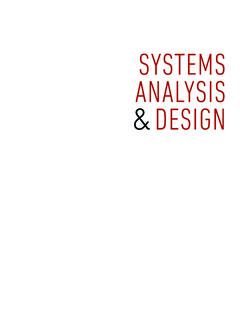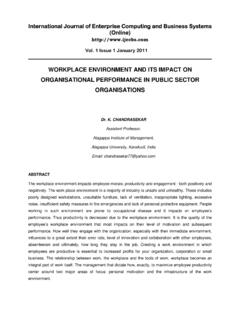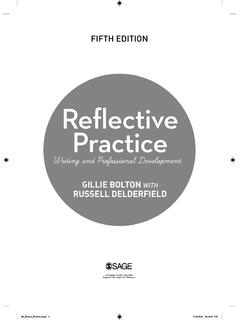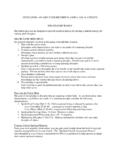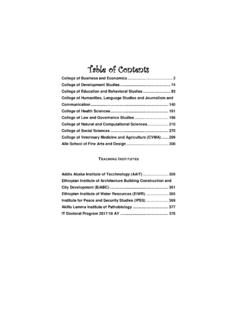Transcription of MANAGEMENT 15E - Pearson
1 Stephen P. RobbinsSan Diego State UniversityMary CoulterMissouri State UniversityWith contributions byAmy RandelSan Diego State 111/18/19 7:48 AMPlease contact with any queries on this 2021, 2018, 2016 by Pearson Education, Inc. or its affiliates, 221 River Street, Hoboken, NJ 07030. All Rights Reserved. Manufactured in the United States of America. This publication is protected by copyright, and permission should be obtained from the publisher prior to any prohibited reproduction, storage in a retrieval system, or transmission in any form or by any means, electronic, mechanical, photocopying, recording, or otherwise.
2 For information regarding permissions, request forms, and the appropriate contacts within the Pearson Education Global Rights and Permissions department, please visit of third-party content appear on the appropriate page within the , ALWAYS LEARNING, and MYLAB are exclusive trademarks owned by Pearson Education, Inc. or its affiliates in the and/or other otherwise indicated herein, any third-party trademarks, logos, or icons that may appear in this work are the property of their respective owners, and any references to third-party trademarks, logos, icons, or other trade dress are for demonstrative or descriptive purposes only.
3 Such references are not intended to imply any sponsorship, endorsement, authorization, or promotion of Pearson s products by the owners of such marks, or any relationship between the owner and Pearson Education, Inc., or its affiliates, authors, licensees, or of Congress Cataloging-in-Publication DataNames: Robbins, Stephen P., author. | Coulter, Mary K., : MANAGEMENT / Stephen P. Robbins, Mary : 15 Edition. | Hoboken, NJ : Pearson , [2020] | Revised editionof the authors MANAGEMENT , [2018]Identifiers: LCCN 2019020717 (print) | LCCN 2019980991 (ebook) | ISBN 9780135581858 | ISBN 9780135581872 (ebook other)Subjects: LCSH: : LCC HD31.
4 R5647 2020 (print) | LCC HD31 (ebook) | DDC 658 dc23LC record available at ebook record available at 10: 0-13-558185-0 ISBN 13: 211/18/19 7:48 AMTo my wife, LauraSteveTo my husband, 311/18/19 7:48 411/18/19 7:48 AMvPreface xxiiiAcknowledgments xxxiPart 1 Introduction to MANAGEMENT 2 Chapter 1: Managers and You in the Workplace 2 MANAGEMENT History Module 22 Chapter 2: Making Decisions 36 Part 1 MANAGEMENT Practice 58 Part 2 Basics of Managing in Today s Workplace 62 Chapter 3: Influence of the External Environment and the Organization s Culture 62 Chapter 4: Managing in a Global Environment 84 Chapter 5: Managing Diversity 108 Chapter 6: Managing Social Responsibility and Ethics 136 Chapter 7: Managing Change and Disruptive Innovation 162 Part 2 MANAGEMENT Practice 194 Part 3 Planning 200 Chapter 8: Foundations of Planning 200 Chapter 9: Managing Strategy 220 Chapter 10: Entrepreneurial Ventures 244 Part 3 MANAGEMENT Practice 270 Part 4 Organizing 274 Chapter 11: Designing Organizational Structure 274 Chapter 12.
5 Managing Human Resources 300 Chapter 13: Managing Groups and Teams 332 Part 4 MANAGEMENT Practice 356 Part 5 Leading 360 Chapter 14: Managing Communication 360 Chapter 15: Understanding and Managing Individual Behavior 382 Chapter 16: Motivating Employees 416 Chapter 17: Being an Effective Leader 448 Part 5 MANAGEMENT Practice 480 Part 6 Controlling 484 Chapter 18: Monitoring and Controlling 484 Planning and Control Techniques Module 514 Managing Operations Module 530 Part 6 MANAGEMENT Practice 542 Brief ContentsGlossary 546 Name Index 557 Organization Index 571 Subject Index 511/18/19 7:48 AMviPreface xxiiiAcknowledgments xxxi Part 1 Introduction to MANAGEMENT 2 Chapter 1: Managers and You in the Workplace 2 Tell Who Managers Are and Where They Work 2 Who Is a Manager?
6 2 Where Do Managers Work? 3 Why Are Managers Important? 4 MANAGEMENT Versus Managers 5 What Is MANAGEMENT ? 5 What Do Managers Do? 6 Managerial Challenges Today and Into the Future 8 Focus on Technology 8 Focus on Disruptive Innovation 9 Focus on Social Media 9 Focus on Ethics 11 Focus on Political Uncertainty 11 Focus on the Customer 11 Why Study MANAGEMENT ? 12 The Universality of MANAGEMENT 12 The Reality of Work 12 Rewards from Being a Manager 13 Gaining Insights into Life at Work 13 Employability Skills 13 Boxed Features FYI 4, 11It s Your Career: The ABC s of Managing Your Time 9 Learning from Failure: Successful Managers Learn from Their Failures 10 Workplace Confidential: Dealing with Organizational Politics 14 Preparing For: Exams/Quizzes 16 Chapter Summary by Learning Objectives 16 Review and Discussion Questions 17 Preparing For: My Career 17 Ethics Dilemma 17 Skill Exercise.
7 Developing Your Skills as a Manager 18 Working Together: Team Exercise 18My Turn to Be a Manager 611/18/19 7:48 AM Contents viiCase Application 1: Working with Artificial Intelligence 19 Case Application 2: Nike: Taking a Customer Focus to a New Level 20 MANAGEMENT History Module 22 Early MANAGEMENT 22 Classical Approach 23 Scientific MANAGEMENT 23 General Administrative Theory 25 Behavioral Approach 27 Quantitative Approach 29 Contemporary Approaches 30 Preparing For: Exams/Quizzes 33 Chapter Summary by Learning Objectives 33 Review and Discussion Questions 34 Preparing For: My Career 34My Turn to Be a Manager 34 Chapter 2: Making Decisions 36 The Decision-Making Process 37 Step 1: Identify a Problem 37 Step 2: Identify Decision Criteria 38 Step 3: Allocate Weights to the Criteria 38 Step 4: Develop Alternatives 39 Step 5: Analyze Alternatives 39 Step 6: Select an Alternative 40 Step 7: Implement the Alternative 40 Step 8.
8 Evaluate Decision Effectiveness 40 Approaches to Decision Making 40 Rationality 41 Bounded Rationality 41 Intuition 42 Evidence-Based MANAGEMENT 42 Crowdsourcing 43 Types of Decisions 44 Structured Problems and Programmed Decisions 44 Unstructured Problems and Nonprogrammed Decisions 44 Comparing Decision Types 45 Decision-Making Styles 45 Decision-Making Biases and Errors 47 Cutting-Edge Approaches for Improving Decision Making 48 Design Thinking 48 Big Data and Artificial Intelligence 50 Boxed Features FYI 37, 43, 48, 51 Let s Get REAL 43 Learning from Failure: James Dyson: A Man of a Thousand Failures 46 Workplace Confidential: Making Good Decisions 711/18/19 7:48 AMviii ContentsPreparing For: Exams/Quizzes 51 Chapter Summary by Learning Objectives 51 Review and Discussion Questions 52 Preparing For: My Career 53 Ethics Dilemma 53 Skills Exercise: Developing Your Creativity Skill 53 Working Together: Team Exercise 54My Turn to Be a Manager 54 Case Application 1: Making Decisions with Bad Data 54 Case Application 2.
9 Bringing Sports Analytics into the Thick of Things 55 Part 1: MANAGEMENT Practice 58A Manager s Dilemma 58 Global Sense 58 Continuing Case: Starbucks Introduction 58 Part 2 Basics of Managing in Today s Workplace 62 Chapter 3: Influence of the External Environment and the Organization s Culture 62 The Manager: Omnipotent or Symbolic? 63 The Omnipotent View 63 The Symbolic View 63 Reality Suggests a Synthesis 64 The External Environment: Constraints and Challenges 64 Defining the Environment and Environmental Uncertainty 64 Monitoring the General Environment 66 The Specific Environment 67 Managing the Environment 69 Organizational Culture: Constraints and Challenges 69 What Is Organizational Culture?
10 70 Strong Cultures 71 Where Culture Comes From and How It Continues 72 How Employees Learn Culture 73 How Culture Affects Managers 77 Boxed Features Let s Get REAL 66, 73 FYI 67, 70 Learning from Failure: A Corrupt Culture at Wells Fargo 74It s Your Career: Reading an Organization s Culture: Find One That Is a Right Fit for You 75 Workplace Confidential: Adjusting to a New Job or Work Team 76 Preparing For: Exams/Quizzes 78 Chapter Summary by Learning Objectives 78 Review and Discussion Questions 79 Preparing For: My Career 79 Ethics Dilemma 79 Skill Exercise: Developing Your Environmental Scanning Skill 811/18/19 7:48 AM Contents ixWorking Together: Team Exercise 80My Turn to Be a Manager 80 Case Application 1: Environmental Uncertainty at HBO 80 Case Application 2: Organizational Culture at Vice Media 81 Chapter 4: Managing in a Global Environment 84 Clarifying Terminology 85A Brief History of Globalization 86 The Case For and Against Glob





